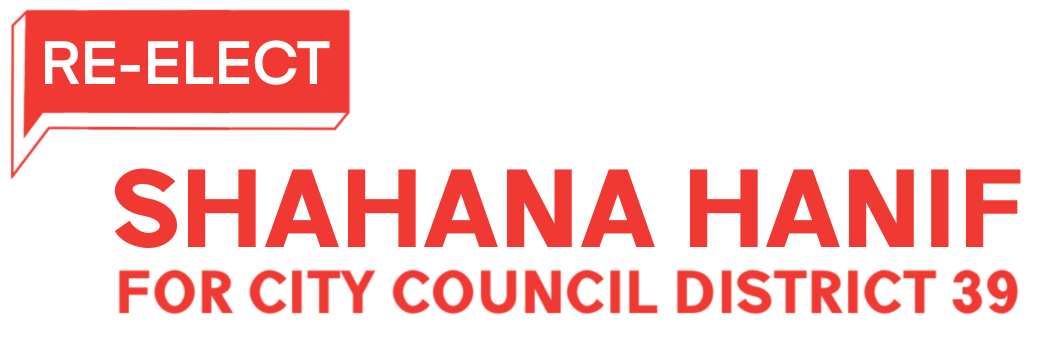CREATING A WALKABLE CITY:
ACCESSIBLE STREETS AND PUBLIC TRANSPORTATION
From a lack of protected bike lanes, to poorly lit streets, to fear of harassment from the NYPD: our streets are dangerous for pedestrians and cyclists, because they are planned for cars, not people. As a Lupus survivor with both hips and her left shoulder replaced, Shahana knows falling due to unpaved streets and unprotected bike lanes makes cycling inaccessible, dangerous, and deadly. However, with the support of groups like Bici Niñxs, a women of color and anti-gentrification bike cooperative, Shahana learned to bike confidently in Brooklyn. Shahana’s vision for safe streets means community-led design rooted in justice and equity - by working with bike shares, cooperatives, cycling community educators, and justice oriented planners, instead of the police, we can create safer streets for all.
Shahana’s vision for street safety centers accessibility. While navigating Lupus and disabilities as a 17 year old, she applied for Access-A-Ride and was denied, forcing her to use inaccessible public transportation and go up and down the stairs of subway stations without elevators and escalators, or paying for expensive car service. Even after she finally received Access-A-Ride approval, Shahana continued to face unreliable service. In the City Council, Shahana will advocate for more accessible public transportation infrastructure, like better entrance ways and elevators in subway stations with steep stairways. Truly safe streets central to climate justice, easily walkable, accommodating, interconnected with a robust public transportation network, and de-carceral.
NYC can and should be a biking and walking city.
As Councilmember, Shahana will:
+ Create lively and open streets
- Fund Safer Streets Initiatives, or programs that make streets safer for pedestrians and cyclists. Aside from existing weekend walks and summer streets promoted by NYC’s DOT, this includes funding and encouraging street vendors, neighborhood block parties, fruit trees, sidewalk art, street furniture, and promoting safe access to play spaces
- Create permanent Open Streets in the City
- Increase Open Streets in neighborhoods of color with fewer public spaces, including Beverly Road on East 2nd
- Connect the district’s Open Streets to make the city safer for cyclists
- Create a new Neighborhood Stewardship Initiative, a program which would hire residents and create new green union jobs to ensure open streets remain truly open with clear barricades, signage, and no police presence, instead of relying on volunteer labor to keep open streets lively
- Promote street safety and traffic-calming mechanisms to reduce accidents and congestion by eliminating curbs, narrowing car lines, increasing crosswalks, adding parking buffers, and constructing pedestrian oriented plazas
- Work with the City Council to implement the 25x25 Plan, reimagining 25 percent of New York City’s streets as space for people, not cars
+ Make cycling safer
- Support the creation of 425-miles of protected bike lanes under the Regional Planning Association’s Five Borough Bikeway proposal
- Prioritize protected bike lanes in the district, focusing on neighborhoods with high incidence of bicycle injuries or fatalities. For instance, only 8% of streets within Borough Park have bike lanes, compared with 45% in Crown Heights and Prospect Heights.
- Fund bike cooperatives and subsidized bike shares, and expand outreach in communities of color
- Partner with transportation activists of color to fund educational programs around bicycling for the district through constituent services. While everyone bikes, infrastructural and systemic barriers (like a lack of protected bike lanes or fear of NYPD intervention) or make cycling more dangerous for communities of color.
- Address the unsafe working conditions faced by the district’s cyclist delivery drivers, and provide more access to restrooms and rest stops for these workers, including app-based delivery drivers who are often blocked from using restrooms at restaurants when out on delivery
- Remove the NYPD from traffic enforcement and move those responsibilities to the city’s Department of Transportation - this is especially crucial for immigrant delivery cyclists who might not report injuries, dangerous driving, and road conditions due to fears of deportation and other consequences from dealing with NYPD.
+ End transportation deserts
- Rethink the MTA bus redesign plan, instead hosting district-specific bus redesign planning sessions with the MTA with attention to outreach in multiple languages, more accessible locations, and digital/virtual engagement options (like Zoom or public radio/ TV broadcast)
- Bring back the B71 bus or a comparable bus that provides East-West support across the Gowanus canal
- Create more bus corridors on 5th Avenue (B63), 7th Avenue (B67/B69), and Church Avenue (B35) to increase frequency, decrease delay time, and and lessen street harassment
- Increase physical accessibility in existing subway stations, such as building elevators at the 7th Avenue Station. While the MTA aims for 100% accessibility by 2034, this requires urgent capital investments and prioritization by City Council.
- Remove NYPD from subway stations
- Advocate for expansion of the on-demand Access-a-Ride (AAR) pilot program to serve all AAR users and allow all users to request service whenever they need one, not a day in advance
- Amend NYC Administrative Code 19-188 to require accessible pedestrian signals at all intersections in New York, such as crossing signals that provide auditory “walk” alerts. Currently, more than 95 percent of New York City’s intersections are in violation of the ADA.
- Hold the MTA to its plan for a fully accessible subway system by 2034, including installation, repair and maintenance of elevators across the subway system.
- Support changes in zoning, like the Transit Easement Certification, which will make it easier for the MTA to add elevators and other station access improvements on developments next to subway stations.
- Push for a renewed Vision Zero - a program that addresses pedestrian fatalities through street design, aiming to create streetscapes that are “accessible, participatory, comfortable, ecological, predictable, multi-sensory, walkable, and predictable.”
